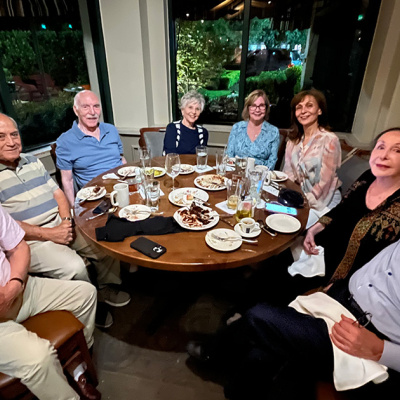UT National Medal of Science Winners Reflect on Their Success
Honored by the President, two UT professors reflect on long scientific careers and what keeps them searching for new discoveries.

At most universities, having two faculty members win the nation’s highest scientific honor would be called remarkable, outstanding, or even amazing. At UT, we call it Goodenough. John Goodenough and Allen Bard, to be specific.
The Tower was lit Tuesday night in honor of Goodenough, the Virginia H. Cockrell Centennial Chair in Engineering, and Bard, the Hackerman-Welch Regents Chair in Chemistry. The UT professors were awarded the National Medal of Science this month, the highest honor the U.S. government can bestow on a scientist or engineer. Goodenough and Bard traveled to Washington D.C. on February 1, where they received the award from President Obama in a ceremony at the White House.
Goodenough, 90, is a thin tweedy man with an infectious laugh. Bard, 79, has a mustache and hairstyle that could earn him honors in an Einstein look-alike contest. Together, they are 2013 National Medal of Science laureates. Their reflections on the award reveal two passionate scientists who care about their colleagues and students, their research, and the University.
"I always knew I wanted to be a scientist," Bard says. "I've always loved it." He says his interest in science was stoked as child by films about legendary scientists like Paul Ehrlich. Awards for scientists aren't a career goal, he insists, but they may help inspire young people to pursue science in the way "Dr. Ehrlich's Magic Bullet" inspired him as a child growing up in New York City.
"I think the big positive aspect is the image of science, especially to young people," he notes.
After graduate studies at Harvard, Bard did what so many pioneering young people have done throughout history—he came to Texas. He was hired as an instructor at UT in 1958. He's been here ever since. Bard says it’s rare for two researchers at the same university to win the award at the same time. It’s good for UT, and Bard says he’s seen UT rise in his time here.
"UT depends on recognition of its faculty," he says.

Few UT faculty members are more recognized than Goodenough, whose scientific career was jump-started after his return from serving in World War II. After studying at the University of Chicago, he went to MIT's Lincoln lab as a group leader, and then to the University of Oxford. In 1986 the Virginia H. Cockrell Centennial Chair in Engineering was established—and Goodenough was recruited for it. The former physicist, and later the chemist responsible for the battery that makes cell phones possible, was now an engineer.
When I visit Goodenough in his office, he's working with a student about a quarter of his age. He says he's proud to be a part of the UT community, and he says Texans live up to their friendly image.
"I have found The University of Texas provides a wonderful culture in which to continue my work," he says. Awards like his can help the University's reputation, and Goodenough insists that UT can compete with the best universities in the world in attracting the best students.
The two long-serving, hard-working scientists are quick to share the credit for their work. Like many academic researchers, they are the leaders of teams, and they both take pride in those group accomplishments. Both say the medal is a reflection of their teams' work.
"It recognizes them," says Bard.
Goodenough shakes his head when asked about winning. He says it makes him grateful to those who taught him and worked with him.
"Nobody does anything alone," he says. "I accept the honor on their behalf."
Editor's note: You can hear Dr. Goodenough's lively laugh around the 1:53 mark in this audio report from American Public Media's "Marketplace".






